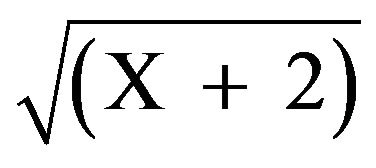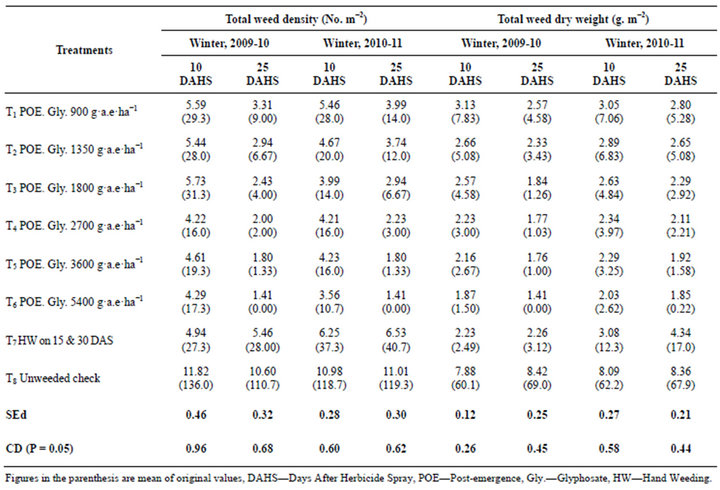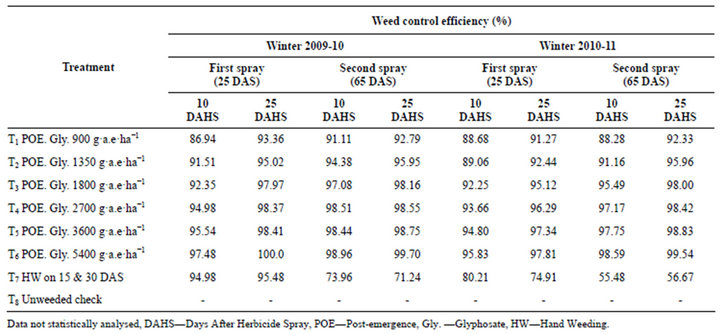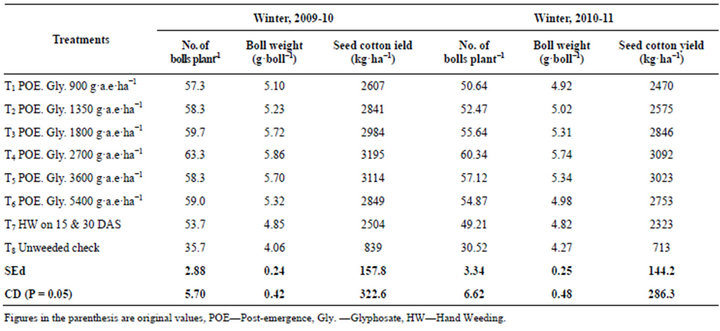American Journal of Plant Sciences
Vol.4 No.6(2013), Article ID:32539,5 pages DOI:10.4236/ajps.2013.46142
Evaluation of Weed Control Efficacy and Seed Cotton Yield in Glyphosate Tolerant Transgenic Cotton
![]()
Department of Agronomy, Tamil Nadu Agricultural University, Coimbatore, India.
Email: *nithiyachinnu@gmail.com
Copyright © 2013 Nithya Chinnusamy et al. This is an open access article distributed under the Creative Commons Attribution License, which permits unrestricted use, distribution, and reproduction in any medium, provided the original work is properly cited.
Received March 25th, 2013; revised April 26th, 2013; accepted May 15th, 2013
Keywords: Herbicide Tolerant Cotton; Weed Control Efficiency; Seed Cotton Yield
ABSTRACT
Cotton is one of the important crops that have been genetically altered to address challenges with weed and insect control. The research was conducted with glyphosate resistant cotton hybrids during winter irrigated season of 2009-10 and 2010-11 at the experimental site of Tamil Nadu Agricultural University, Coimbatore, with the objective, to find out the weed control efficacy and yield of transgenic cotton hybrid with the application of glyphosate. Glyphosate was applied as post-emergence application on 25 and 65 DAS at 900, 1350, 1800, 2700, 3600 and 5400 g a.e./ha in MRC 7347 BGII RRF test hybrid. These treatments were compared with hand weeding on 15 and 30 DAS and unweeded control. In both sprays, post-emergence application of glyphosate 2700, 3600 and 5400 g a.e./ha registered lower weed density and higher weed control efficiency in transgenic cotton hybrid compared with other treatments. Seed cotton yield (3195 and 3092 kg·ha–1 during 2009-10 and 2010-11 respectively) was significantly higher in post-emergence application of glyphosate at 2700 g a.e./ha. Increased use of transgenic cotton with herbicide and pest resistance has resulted in more efficient insect and weed management practices.
1. Introduction
Cotton hybrids are cultivated under wider plant spacing and heavily fertilized, which in turn invite multiple weed species infestation. Due to increased scarcity of labourers, manual weeding is not economical and the available preemergence herbicide has lesser weed control efficiency in controlling major problematic weeds.
Critically viewing, the manual and mechanical methods of weed control, besides being less effective, are costly, time consuming and to be repeated at frequent intervals. Mechanical weed control method was partially effective because most of the weeds growing in intra rows escaped weeding and incessant rains make the manual weeding impossible which resulted in an inefficient weed control situation and low seed cotton yield [1].
The available post-emergence herbicides are mostly non-selective and even directed spray of some herbicides cause considerable crop damage. This necessitates the development and testing of selective early post emergence herbicides for weed control in cotton. Under these circumstances, Roundup Ready Flex (RRF) Bollgard II cotton hybrid which is resistant to both bollworms and glyphosate would be an added advantage to the cotton growers. This new technology is likely to reduce the cost of production and insecticide application by providing an effective alternative to chemical insecticides for control of Helicoverpa armigera [2].
With these in view, evaluation of weed control efficiency and yield of glyphosate resistant cotton hybrids has been taken up during winter season (August sowing) of 2009 and 2010 with the objectives of, to assess the effect of glyphosate on the weed control efficacy in winter irrigated herbicide tolerant cotton hybrid and to find out the influence of glyphosate on seed cotton yield of herbicide tolerant cotton.
2. Materials and Methods
2.1. Experimental Site and Initial Soil Characteristics
The research was conducted with glyphosate resistant cotton hybrids during winter season of 2009-10 and 2010-11 at experimental site of Tamil Nadu Agricultural University, Coimbatore, Tamil Nadu. The farm is situated in Western Agro climatic zone of Tamil Nadu with 11˚N longitude, 77˚ E latitude and at an altitude of 426.7 m above mean sea level and the farm receives the normal total annual rainfall of 674.2 mm in 45.8 rainy days. Trial was conducted in soil with sandy clay loam type of soil and the soil was medium in organic carbon content and the available nutrient status was low in nitrogen, medium in phosphorus and high in potassium.
2.2. Experimental Design, Selection of Cultivar and Sowing
The experiment was laid out in randomized complete block design (RBD) with eight treatments and replicated thrice. The gross plot size adopted was 48.6 Sq. meter (9.0 m × 5.4 m). Herbicide tolerant transgenic cotton test hybrid MRC 7347 BG-II RRF was used for the study. The cotton was sown manually keeping the distance of 90 × 90 cm at 2.5 kg·ha−1 of delinted seeds during winter irrigated season of Tamil Nadu. After sowing the seed, immediately a light irrigation was given to the crop for uniform germination.
2.3. Treatment Details
Treatments consisted of post-emergence application of glyphosate (50% EC) at 900, 1350, 1800, 2700 and 3600 g·ha−1 at 25 and 65 Days After Sowing, Hand weeding twice on 15 and 30 DAS and unweeded check. For all the treatments earthing up was uniformly given at 45 DAS. As per the treatment schedule glyphosate was applied as post-emergence. Hand operated knapsack sprayer fitted with a flat fan type nozzle (WFN 40) was used for spraying the herbicides adopting a spray volume of 500 litres·ha−1.
2.4. Observations on Weeds
2.4.1. Weed Density
The weed count was recorded species wise using 0.5 m × 0.5 m quadrat from four randomly fixed places in each plot and the weeds falling within the frames of the quadrat were counted and the mean values were expressed in number·m−2. The densities of grasses, sedges and broad leaved weeds and the total weeds were recorded at 10 and 25 days after first and second spraying of glyphosate and expressed in number·m−2.
2.4.2. Weed Dry Weight
The weeds falling within the frames of the quadrat were collected, categorised into grasses, sedges and broadleaved weeds, shade dried and later dried in hot-air oven at 80˚C for 72 hrs. The dry weight of grasses, sedges and broadleaved weeds were recorded separately at 10 and 25 days after first and second spraying of glyphosate and expressed in kg·ha−1.
2.4.3. Weed Control Efficiency
Weed control efficiency (WCE) was calculated as per the procedure [3].

whereWCE: weed control efficiency (percent).
WDc: weed biomass (g·m−2) in control plot.
WDt: weed biomass (g·m−2) in treated plot.
2.5. Statistical Analysis
The data were statistically analysed following the procedure [4] for randomised block design. The data pertaining to weeds were transformed to square root scale of
 . Whenever significant difference existedcritical difference was constructed at five per cent probability level. Such of those treatments where the difference are not significant are denoted as NS.
. Whenever significant difference existedcritical difference was constructed at five per cent probability level. Such of those treatments where the difference are not significant are denoted as NS.
3. Results and Discussion
3.1. Predominant Weed Flora of the Experimental Field
Weed flora of the experimental field predominantly consisted of twelve species of broad-leaved weeds, five species of grasses and a sedge weed. Dominant among grassy weeds were Dactyloctenium aegyptium Beauv. and Cynodon dactylon (L.) Pers. Trianthema portulacastrum (L.), Cleome gynandra (L.), Digera arvensis (Forsk) and Parthenium hysterophorus (L.) were the dominant ones among the broad-leaved weeds. Cyperus rotundus (L.) was the only sedge present in the experimental fields.
Dactyloctenium aegyptium, Cynodon dactylon, Cyperus rotundus, Trianthema portulacastrum, Parthenium hysterophorus and Digera arvensis were the dominant weed flora in the experimental field which caused a lot of management problems during both the seasons. Cyperus rotundus, Cynodon dactylon and Trianthema portulacastrum were the most common weeds which compete with cotton and could assimilate biomass faster than cotton [5].
3.2. Weed Control Efficacy
The total weed density was significantly altered by different weed control treatments during both the years. Before first spraying of herbicide, lower density of total weeds were recorded in hand weeding. Whereas, at 10 and 25 days after herbicide spraying, glyphosate at 2700, 3600 and 5400 g·a.e·ha−1 registered significantly lower total weed density, which were also comparable with hand weeding twice. Lower doses of glyphosate at 900, 1350 and 1800 g·a.e·ha−1 did not prove effective in controlling total weeds (Table 1).
Considerable reduction in the density of grasses, sedge and broad leaved weeds were observed under glyphosate at 5400, 3600 and 2700 g·a.e·ha−1. Glyphosate controlled a broad spectrum of annual and perennial grasses, sedge, and broadleaf weeds and might be a viable alternative to other commonly used herbicides [6]. Glyphosate applied at lower doses was not effective in controlling sedge weed, Cyperus rotundus and some broad leaved weeds like Parthenium hysterophorus and Commelina benghalensis. Glyphosate provided marginal or no control of weeds such as Bermuda grass (Cynodon dactylon (L.) Pers.), hemp dogbane (Apocynum cannabinum L.), hemp Sesbania, Ipomoea species, horse nettle (Solanum carolinense L.) and tropical spiderwort (Commelina benghalensis L.) [7].
Glyphosate was applied at two stages viz., 25 and 65 DAS in glyphosate tolerant transgenic cotton. Most significant weed interference occured during the first eight weeks after cotton emergence and a linear decrease in cotton yield could be expected with increasing weed densities [8]. In this view, first glyphosate spray controlled early season weeds and the second glyphosate spray controlled weeds up to harvest.
At 25 days after first herbicide spraying, application of glyphosate at 5400, 3600 and 2700 g·a.e.·ha−1 recorded lower weed dry weight due to better control of weeds at critical stage (50 DAS) of crop growth during winter 2009-10 and 2010-11, in herbicide tolerant transgenic cotton (Table 1).
During winter 2009-10, at 10 days after first spraying of herbicide, higher weed control efficiency of 97.48 per cent was recorded in glyphosate at 5400 g·a.e·ha−1 (Table 2). At 25 days after first spraying, higher weed control efficiency (98.41 per cent) was observed with glyphosate at 3600 g a.e ha-1 followed by glyphosate at 2700 and 5400 g·a.e·ha−1 which resulted with more than 98 per cent of WCE. During second spraying of glyphosate also, higher weed control efficiencies of 98.96 and 99.70 per cent were recorded with glyphosate at 5400 g·a.e·ha−1 at 10 and 25 days after second spraying, respectively. Glyphosate at 2700 and 3600 g·a.e·ha−1 were the next superior treatments in recording higher weed control efficiencies of 98.55 and 98.75 percent at 25 days after second spraying of herbicide.
Weed control efficiency at 10 and 25 days after first spraying of glyphosate was higher with 95.83 and 97.81 percent in glyphosate at 5400 g·a.e·ha−1 during winter

Table 1. Effect of glyphosate application on total weed density and total weed dry weight in herbicide tolerant transgenic cotton.
.
2010-11 (Table 2). During both the stages of observation, hand weeding twice accounted lower weed control efficiency of 80.21 and 74.91 percent. Like first spray, in second spraying also higher weed control efficiency (98.59 and 99.54 percent) was recorded with glyphosate at 5400 g·a.e·ha−1.
Cotton productivity is mainly decided by the weed control efficiency of weed management methods. Trends in cotton yield reflected through weed control, which was further proved through glyphosate application system provided 96 per cent control of weeds, producing greater than 950 kg·ha−1 of seed lint cotton [9].
3.3. Seed Cotton Yield
During both the years of study, among the treatments, glyphosate at 2700 g·a.e·ha−1 recorded higher seed cotton yield of 3195 and 3092 kg·ha−1 during winter 2009-10 and 2010-11, respectively. This was followed by glyphosate at 3600 g·a.e·ha−1 (3114 and 3023 kg·ha−1) and glyphosate at 1800 g·a.e·ha−1 (2984 and 2846 kg·ha−1) registering higher seed cotton yields during first and second year of study, respectively (Table 3). However these above said treatments did not differ significantly with glyphosate at 2700 g·a.e·ha−1 in recording higher seed cotton yield.

Table 2. Effect of different weed management methods on weed control efficiency (per cent) in herbicide tolerant transgenic cotton.

Table 3. Effect of weed control methods yield attributes and seed cotton yield in herbicide tolerant transgenic cotton.
Treatments such as glyphosate at 900, 1350 and 5400 g·a.e·ha−1 recording comparatively lesser seed cotton yields than other doses, but were comparable to hand weeding twice. Whereas, unweeded control recorded low-er seed cotton yield of 839 and 713 kg·ha−1 with first and second years, respectively. Increased use of transgenic cotton with herbicide and pest resistance has resulted in more efficient insect and weed management practices.
Higher yield of herbicide tolerant transgenic cotton recorded with glyphosate at 2700 g·a.e·ha−1 over hand weeding twice (21.6 percent) and (24.9 percent) and unweeded control (73.7 percent) and (76.9 percent) during winter 2009-10 and winter 2010-11, respectively. It could be attributed to efficient control of weeds during the cropping period. Roundup Ready Flex cotton could provide producers with acceptable weed control without compromising cotton yield [3]. Seed cotton yield was maximized with the glyphosate POST program that included three applications of glyphosate and also stressed the importance of early-season weed control as well as controlling weeds late in the season [10].
4. Conclusion
From the results of the field experiments, it could be concluded that post emergence spraying of potassium salt of glyphosate at 2700 g·a.e·ha−1 twice on 25 and 65 DAS can be done for complete control of broad spectrum weeds with higher seed cotton yield in herbicide tolerant transgenic cotton during winter season.
REFERENCES
- V. R. Rajeswari and N. R. Charyulu, “Integrated Weed Control in Cotton,” ANNALS of Agricultural Research, Vol. 17, No. 4, 1996, pp. 438-440.
- F. Huang, L. L. Buschman and R. A. Higgins, “Larval Feeding Behaviour of Dipel Resistant and Ostrinia nubilalis on Diet Containing Bacillus thuringiensis (Dipel ESTM),” Entomologia Experimentalis et Applicata, Vol. 98, No. 2, 2002, pp. 141-148. doi:10.1046/j.1570-7458.2001.00768.x
- C. L. Main, A. J. Michael and E. C. Murdock, “Weed Response and Tolerance of Enhanced Glyphosate-Resistant Cotton to Glyphosate,” Journal of Cotton Science, Vol. 11, No. 2, 2007, pp. 104-109.
- K. A. Gomez and A. A. Gomez, “Statistical Procedures for Agricultural Research,” Wiley India Pvt. Ltd., New Delhi, 2010.
- I. Gnanavel and S. Babu, “Integrated Weed Management in Irrigated Hybrid Cotton,” Agricultural Science Digest, Vol. 28, No. 2, 2008, pp. 93-96.
- J. W. Wilcut, H. D. Coble, A. C. York and D. W. Monks, “The Niche for Herbicide-Resistant Crops in US Agriculture,” In: S. O. Duke, Ed., Herbicide-Resistant Crops: Agricultural, Environmental, Economic, Regulatory, and Technical Aspects, CRC Press, Boca Raton, 1996, pp. 213-230.
- C. H. Koger and R. N. Reddy, “Glyphosate Efficacy, Absorption and Translocation in Pitted Moringglory (Ipomoea lacunose),” Weed Science, Vol. 53, No. 3, 2005, pp. 277-283. doi:10.1614/WS-04-098R
- C. H. Tingle, G. L. Steele and J. M. Chandler, “Competition and Control of Smell Melon (Cucumis melo var. dudaim Naud.) in Cotton,” Weed Science, Vol. 51, No. 4, 2003, pp. 586-591. doi:10.1614/0043-1745(2003)051[0586:CACOSC]2.0.CO;2
- W. J. Grichar, B. A. Besler, K. D. Brewer and B. W. Minton, “Using Soil-Applied Herbicides in Combination with Glyphosate in a Glyphosate-Resistant Cotton Herbicide Program,” Crop Protection, Vol. 23, No. 10, 2004, pp. 1007-1010. doi:10.1016/j.cropro.2004.03.004
- D. M. Scroggs, D. K. Miller, J. L. Griffin, J. W. Wilcut, D. C. Blouin, A. M. Stewart and R. P. Vidrine, “Effectiveness of Pre Emergence Herbicide and Post Emergence Glyphosate Programs in Second-Generation GlyphosateResistant Cotton,” Weed Technology, Vol. 21, No. 4, 2007, pp. 877-881. doi:10.1614/WT-07-040.1
NOTES
*Corresponding author.

